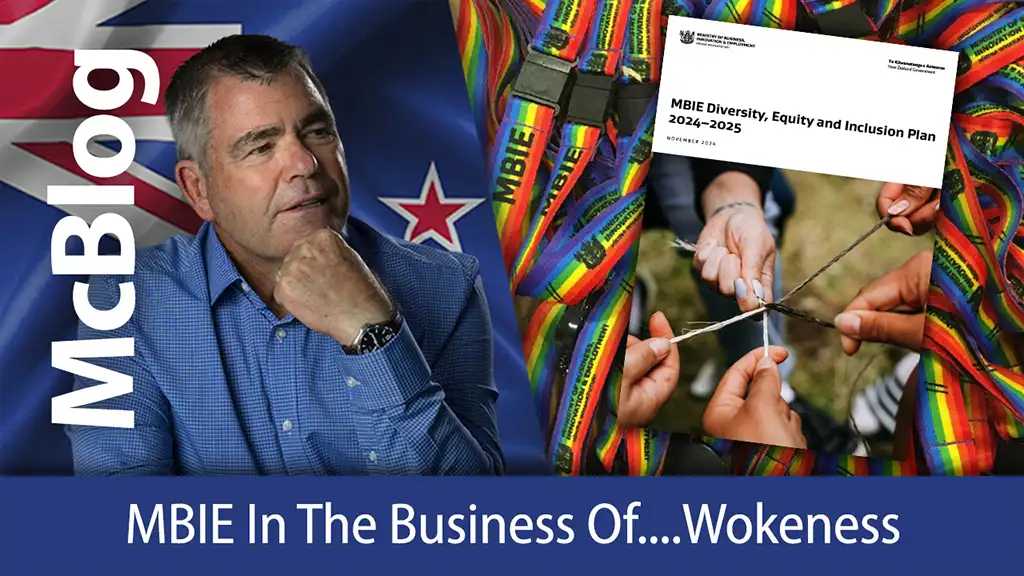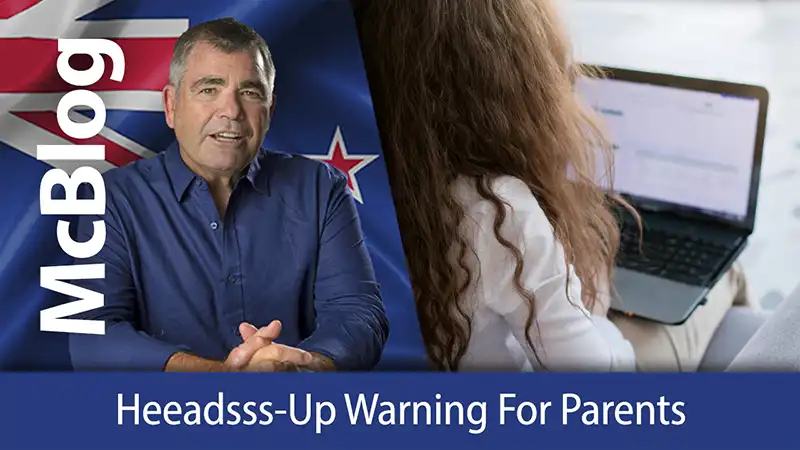Oranga Tamariki has just signalled it’s ready to knock on family doors if they refuse to let their children change gender. A loving family who want to protect their child from confusion, chemicalisation and castration will warrant possible removal of the child from that loving family in the interests of radical gender theory.
TRANSCRIPT:
Oranga Tamariki has just signalled it’s ready to knock on family doors if they refuse to let their children change gender. While OT already has the power for children officially “in care”, it now says it can intervene in any family if it believes parental resistance to transitioning threatens the child’s “emotional wellbeing”.
This is a report from The Centrist news service – one of the many new news services to pop up as trust in the mainstream media plummets. Here’s what their report said
Oranga Tamariki has just signalled it’s ready to knock on family doors if they refuse to let their children change gender.
While OT already has the power for children officially “in care”, it now says it can intervene in any family if it believes parental resistance to transitioning threatens the child’s “emotional wellbeing”.
A response to an Official Information Act (OIA) request indicates, not surprisingly, that the government may take steps to protect children if there are concerns about the child’s physical safety in the face of parental opposition.
However, the far broader brush of protecting “emotional wellbeing”, which does not necessarily include threats of physical violence or any behavioural indicators to substantiate, is also a possible basis for ministry intervention.
Centrist submitted the OIA to the Ministry of Children–Oranga Tamariki seeking to understand whether children outside the direct care of the agency could receive support from the ministry if their familial caregivers opposed their decision to transition.
Oranga Tamariki’s response
While OT says that parental resistance to a young person’s transitioning “would not normally be a concern in and of itself in the absence of any other risk factors”, they elaborate:
“There may be times where a situation involving a rangatahi [young person] who is actively considering or is in the process of transitioning is facing resistance from whānau that may be having an impact on their safety and wellbeing.”
So the resistance to protect a child from confusion, chemicalisation and castration is a problem.
What constitutes “serious harm”?
OT’s response notes that intervention may be based on circumstances in which a child is “likely to suffer” from “serious harm”, which includes “more than an average disagreement” between the child and parent. Those differences could include parents who did not support transitioning, expressed in a way which impaired the child’s “emotional wellbeing”.
OT’s guidance on so-called “serious differences” are described, in part, as “likely” to be irreconcilable, and result in the child “suffering emotional harm due to the breakdown in their relationship with their parent or caregiver”. Such differences could include disagreements and arguments about a young person’s “identity and cultural connection”.
There’s a whole lot of wiggle room there for an OT social worker who wants to push the gender ideology against the parents. And remember this is a young person with likely other presenting mental health issues
Emotional wellbeing
Not normally be a concern
actively considering or is in the process of transitioning is facing resistance
likely to suffer
more than an average disagreement
“likely” to be irreconcilable
suffering emotional harm due to the breakdown in their relationship with their parent or caregiver
young person’s “identity and cultural connection”.
Now The Centrist kindly released the OIA documentation to me – and as well as the issues they have correctly, raised, here’s a few others.
The letter starts almost immediately with this statement
Gender identity is crucial in the development of a young individual as it is a big part of their personal and social identity. We encourage our kaimahi to be guided by rangatahi when determining how best to engage with whānau or family or caregivers regarding their views about the gender identity or sexuality of their tamaiti or rangatahi and the supports they may need to fully accept and affirm their identity.
You see immediately that there is a wholesale acceptance that gender identity needs to be accepted and affirmed. The child’s views of themselves – a child’s – is the starting point. And gender fluidity is a given – which of course is a lie.
OT then makes up complete porkies as it talks about the child’s so-called rights
The rights of tamariki and rangatahi to freedom of expression and fulfilment of personality and identity, including gender identity and sexuality, are set out in the United Nations Convention on the Rights of the Child (UNCRoC), which includes specific provisions for the rights of indigenous children…
These rights are also embedded in the principles of the Oranga Tamariki Act 1989 (section 5(b)(i) and 5(b)(vi)(E) and (F)) and reflected in the National Care Standards Regulations (section 30(4)(c)), which specify that gender identity and sexual orientation are part of identity and cultural needs.
Here’s the problem. Gender identity and sexuality are mentioned nowhere in UNCROC. OT have made that up.
Do a word search on gender or sexuality. Zilch. This is the paragraph on “identity”
8. Identity
Children have the right to their own identity – an official record of who they are which includes their name, nationality and family relations. No one should take this away from them, but if this happens, governments must help children to quickly get their identity back.
Name, nationality and their family. Biology.
Section 29 also talks about “identity” but as it relates to the cultural identity of the child’s parents.
So there’s nothing about sexuality or gender identity.
Then they refer to the Oranga Tamartiki Act 1989 section 5
Let’s have a look
Principles to be applied… the well-being of a child or young person must be at the centre of decision making that affects that child or young person… including those rights set out in UNCROC…and the child or young person must be… protected from harm:
Oh ok. So according to the recent CASS report and the leaks from WPATH and the latest research out of Finland and Sweden and Netherlands etc etc, we should definitely protect a child from going down the harmful road of trying to change their sex – trying. We should heal the mind, not cut the body.
But then further down, you’ll see that a holistic approach must be taken including whakapapa, cultural identity, gender identity and sexual identity.
Here’s the interesting thing. These changes came about as a result of the Children, Young Persons, and Their Families (Oranga Tamariki) Legislation Act 2017
And then also Oranga Tamariki (National Care Standards and Related Matters) Regulations 2018 is referred to.
Cultural safety refers to items such as gender; or sexual orientation or gender identity; or interestingly religious or spiritual belief – except of course that belief that you are born male or female and that you can’t change sex, or that marriage is a man and a woman, or that certain forms of sexuality or that pornography or that sex outside of marriage are considered sin – then you’re definitely not in the circle of cultural safety.
Now I was interested in this difference between gender or gender identity so I went to the Practice Centre of Oranga Tamariki and it is very helpful for me to learn wokeness and just how far down the deep dark hole our so-called child welfare agency has gone
Gender refers to the attitudes, feelings and behaviours that a given culture associates with a person based on their sex, male or female (binary), assigned at birth.
Gender identity is the gender someone identifies with most: a sense of being a man, woman, fa’afafine, gender queer, trans, non-binary, gender fluid or something else.
Then there’s an explanation of sexual orientation and LGBTTTIQ – I thought it was LGBTQUIA+ – and where did all the T’s come from. Its Transgendered, Transexual, Two-spirited.
“Two-spirit” refers to a person who identifies as having both a masculine and a feminine spirit, and is used by some Indigenous people to describe their sexual, gender and/or spiritual identity.
And then further down, how to affirm
Link to Rainbow Youth
Guidelines for gender affirming healthcare for gender diverse tamariki and rangatahi –
none other than WPATH (the radical international group which has been discredited) and PATHA & Waikato Trans Unit which is a radical group of activists that we’ve discussed previously – with their deeply flawed guidelines which the Ministry of Health must relegate to the rubbish bin.
But here’s what the OIA from OT says
It is important that the caregiver’s beliefs and views about gender identity and sexual orientation are explored in the caregiver assessment process rather than waiting until after they have begun to care for a child or young person who may be gender diverse…. Tamariki and rangatahi have the right to access support from Rainbow Youth or other agencies which support gender identity and sexuality… Support plans can also include ensuring caregivers are linked to appropriate support organisations such as Rainbow Youth or Inside Out
You’ll notice it’s not pastoral counselling or counselling from a christian youthworker who is walking with the family – nope it’s the holy grail of RainbowYouth or InsideOut.
In other words, conversion therapy in the direction the state sanctions.
And the parents or caregivers can get some support from InsideOut – you know, a session of Relationships and Sexuality Education curriculum and a test on how many sexualities and gender identities there are, and preferred pronouns.
If concerns were raised regarding a caregiver not supporting rangatahi with their health needs or that they were responding in ways that were not supportive of the child or young person’s gender identity needs being met, this could be considered through such a review process. Our priority is to ensure the safety and oranga (holistic wellbeing) of te tamaiti or rangatahi through the course of their care journey. Where it is assessed that, despite appropriate support and training, a caregiver is not able or willing to support the rights of a tamaiti or rangatahi to express their identity, alternative placement options would be explored in partnership with te tamaiti or rangatahi and their whānau or family, the caregivers and others involved with them.
It’s pretty clear that OT will push a gender fluidity message and if children don’t get their way and kick up a stink, OT and RainbowYouth and InsideOut will be there to practice conversion therapy on the child and help get them over the line to chemicalisation, castration and confusion.
OT really needs to read the CASS report and watch a few McBLOGs where we’ve highlighted all the research exposing this flawed ideology.
The state agency which is supposed to act in the best interests of vulnerable children is focused on making them more vulnerable by dragging them into gender confusion and add to that trauma by separating them from their family & whanau who in most cases will have the very best interests of the child at heart.
The state makes terrible parents compared to loving mums and dads,



